AMD Announces Carrizo and Carrizo-L, Next Gen APUs for H1 2015
by Ian Cutress on November 20, 2014 5:45 PM EST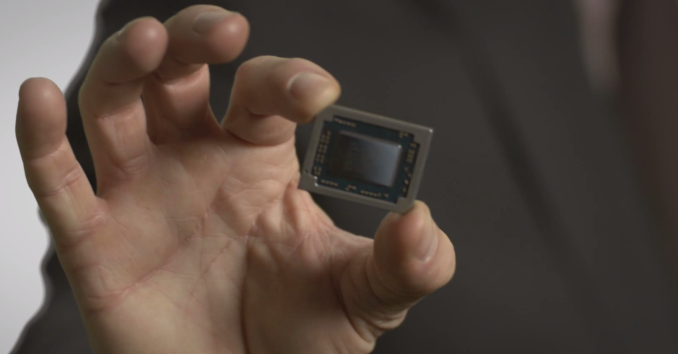
Today AMD is announcing the long anticipated upgrade to Kaveri, codenamed Carrizo. Carrizo is the natural successor to Kaveri, featuring x86 ‘Excavator’ cores alongside a Radeon-class GPU and promising an increase in performance all around. The second part of today’s announcement is for Carrizo-L, an SoC pairing “Puma+” (upgraded Beema) cores also with AMD’s R-series GCN GPUs and a FCH into a single package. Both Carrizo and Carrizo-L will feature ARM Trustzone, giving potential hardware-based built-in security when used by developers.
The Excavator cores are an architectural improvement over Steamroller, but are fundamentally based on the original Bulldozer concept. Excavator will be AMD’s fourth iteration of the concept, following Bulldozer, Piledriver and Steamroller. This new generation of APUs are still set to be built on the 28nm Super High Performance process at Global Foundries, delaying AMD’s shift to 20nm, but AMD are still claiming that the new GPU in Carrizo is their best yet, giving better performance and efficiency than before.
Given AMD's discrete GPU lineup, the GPU for Carrizo could be based on AMD's latest GCN 1.2 architecture, which was first introduced in the desktop Tonga part earlier this year. GCN 1.2's lossless delta color compression algorithms help improve the performance in memory bandwidth limited scenarios, such as in APUs. This could result in a bigger-than-expected jump in performance, although we will wait until we can test to find out how much it helps.
The Carrizo platform will be fully HSA 1.0 compliant, compared to Kaveri which only had ‘HSA Features’, as AMD puts it in their latest mobility roadmap update:
The push from AMD into HSA compliant APUs was well documented back at the launch of Kaveri earlier this year. This enabled the CPU and GPU components of the silicon, while under OpenCL 2.0 mode, to have access to the main block of system DRAM with zero-time copy functions, offering the potential for large classes of applications especially those in the prosumer and industry space to be accelerated by having instant access to the parallelization afforded by the GCN GPU. One of the big drawbacks of being an earlier adopter to HSA, as we noted at the time, was that software developers required time to bring their code to market, as well as AMD having to go out and teach the developers how to cater for HSA topology.
Both Carrizo and Carrizo-L on the mobile side will be targeted at the same power bands as Kaveri and Beema, although the socket will be new. The use of FP4 BGA also indicates that a single socket will cater for both the Excavator and Puma+ based APUs and would be interchangeable. A video by AMD’s VP/GM for Computing and Graphics, John Byrne, states that Carrizo and Carrizo-L are currently being tested internally ready for a 1H 2015 release, along with support for DirectX 12, OpenCL 2.0, Mantle and Freesync.
One of the big features that AMD is pushing with Carrizo is energy efficiency, with it being a keystone of the message. Because AMD have been on the same process node for a short while, they have to essentially follow the Maxwell example, by providing more performance for less power without the advantage of shrinking resistors. We were provided with an energy efficiency roadmap as well, showing the different methods AMD is using to achieve this:
One example of the efficiency improvement was provided by AMD’s Voltage Adaptive Operation. Rather than compensate for voltage variations which wastes energy, this technology takes the average operating voltage and detects when the voltage increases beyond a smaller margin. To compensate for this increase, the CPU speed is reduced until the voltage drops below the threshold and then the CPU speed is moved back up.
The changes in speed are designed to be so minute that it does not affect overall performance, however it might only take an errant voltage delivery component to consistently make the voltage go above that threshold, causing erratic slowdown that might be statistically significant. It will be interesting to see how AMD implements the latest version of this feature.
The 2015 desktop roadmap remains unpublished so far. AMD’s perception of a mobile-focused strategy would tend to suggest that the mobile comes first, with desktop following behind, although at this point it is unclear. A number of AMD’s marketing materials with this launch gave examples of the use of Carrizo and HSA for the prosumer, indicating that a desktop version should be announced in due course.
As of yet there was no discussion on the APUs to be launched, the speeds or the capabilities. All the roadmap tells us is 'up to four cores' (Excavator for Carrizo, Puma+ for Carrizo-L), some GCN compute units and 10-45W overall. There is no mention of DDR4 support, although the timeframe might be relevant for AMD to make the jump. Given the launch is still at least two quarters away, I would expect better details in due course. That timeframe fits in nicely around or just after Computex, perhaps indicating more details then.
Source: AMD


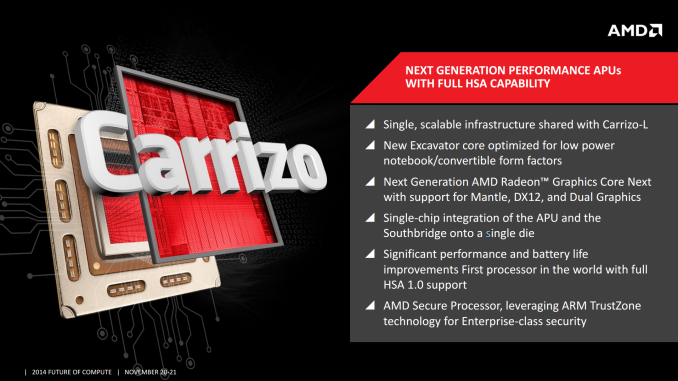
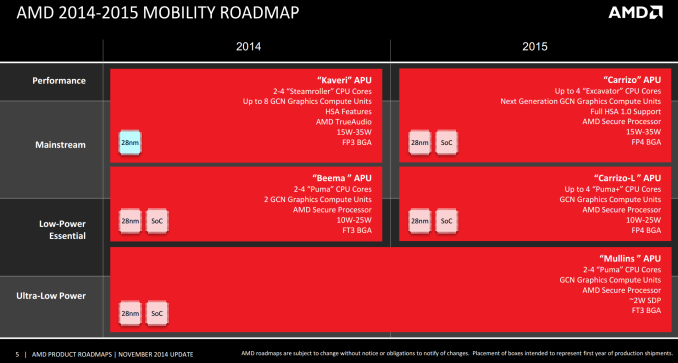
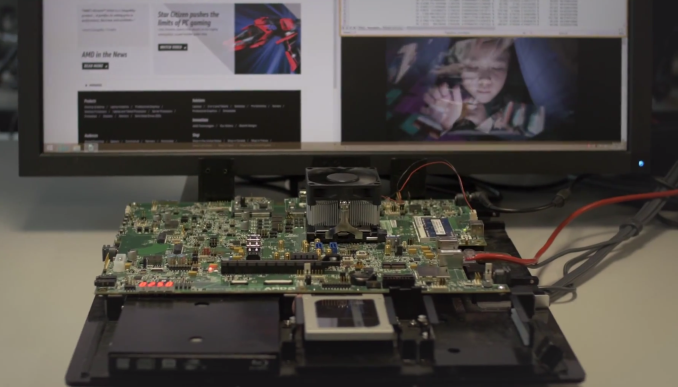
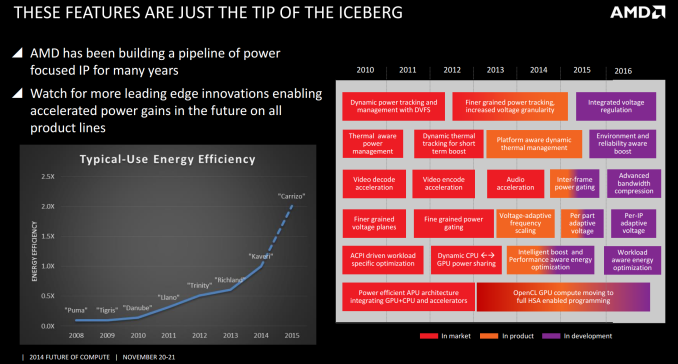
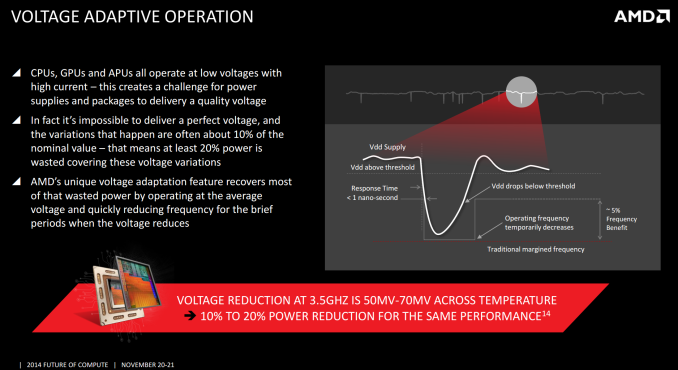
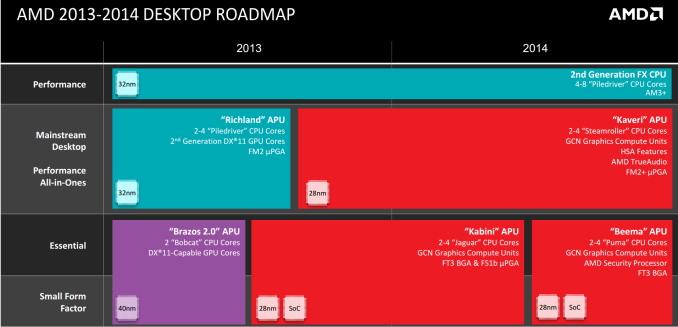








94 Comments
View All Comments
wiyosaya - Wednesday, December 3, 2014 - link
While there is a part of me that agrees with the majority of the comments in regards to the couch potato that AMD has become, we should all remember that AMD is now run by a highly capable EE PhD rather than some business wonk who was set to rest on his laurels while the competition went to deep space and beyond. Certainly there is no guarantee that the PhD will bring the company back to the AMD glory days to which the competition could only respond with the dismal CORE series, there is a much better probability that the PhD will or has put them back on track to really innovate. Changing direction with the current products would not make much business sense as I see it. We all know just how bad delaying products makes AMD look. Selling something is better than throwing away everything and starting over - at least as I see it.Personally, I built a HTPC with a 7850K and replaced a linux server running an Athlon II X3 445 with an Athlon 5350. The HTPC works very well though I do not use it for gaming, and I was expecting the 5350 to be slower than the 445. Much to my surprise, the 5350 seems to be easily out performing the 445 even though its TDP is 1/4 that of the 445.
As it stands, AMD has a great basis for the future, at least to me anyway. Let's hope the EE PhD realizes this, applies the tweaks needed to make the concept a superior platform, and leads the company back to its glory days.
Right now, I think it makes sense from a business standpoint to stay at the same node as it keeps valuable research dollars in the company coffers. K12 would be an obvious candidate for a significant node shrink, and having been an AMD fan for a long time, I hope to see this happen.
Arabian Before Florida Became Florida - Friday, December 19, 2014 - link
For the safety of the public. AMD needs to sell an APU processor without the Weaponized (ARM)Trustzone. These cores allow remote access to your device that no Operating System can detect.Arabian Before Florida Became Florida - Friday, December 19, 2014 - link
http://www.arm.com/products/security-on-arm/trustz...Clinton Balanced Budget. ~ $17 Trillion Debt.. $8 Trillions is just to attack the public..
timberghost - Friday, April 3, 2015 - link
Zepi sounds like he's very technical and very much into everything gaming, and the gaming community is truly the only thing that's keeping enthusiasts alive and well..... What AMD should do or not do I'm not sure because the Intel "Core i" series is stomping them very badly for some years now, AMD should definitely not try to embrace their old glory days of their prowess as a DIY builders choice for a gaming system. At the defense of AMD though, I truly believe they have hung in there very well as the only real threat to giving Intel any kind of competition ( even though it's incredibly minute) and I say this---- their APU's freaking kick Intel's ass graphics wise FOR THE MONEY and I hope AMD keeps improving the whole APU paradigm. Not all users want or need to play games at incredibly high frame rates! We have built 4 AMD APU computers for people doing Pro Audio Apps like, Image Line FL Studio, Cakewalks Sonar Platinum, Pro Tools, Nuendo, Cubase, and Reason, and you can hook up like two or more 4K Monitors to the AMD A10 7850 with no problem at all with 16GB RAM and some great SSD's for Windows and Sample Drives.....it freaking works ----we're talking $1300 systems that kick ass in Pro Audio DAW software, try buying a Mac With two SSD's 16 GB of RAM and a Corsair 850 WATT PS, hallelujah AMD still rocks in other Apps other than gaming....God bless AMD! Keep going baby, if only to be a thorn in Intel's side, and stop a potential monopoly!